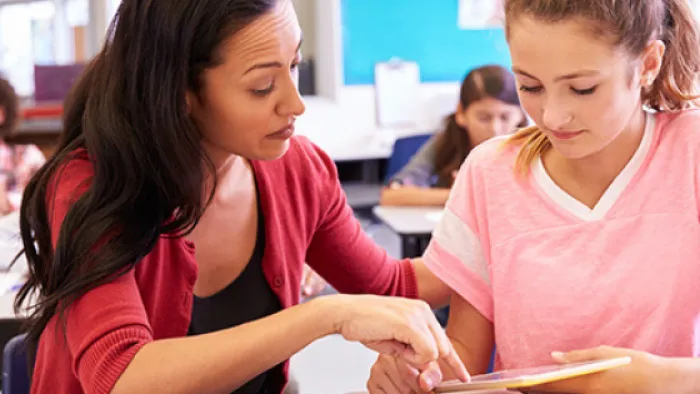Learn simple but important ways to evaluate your edtech choices.

Any classroom teacher will tell you the importance of differentiating instruction and materials for students' diverse needs. It's also crucial that when you introduce a new digital learning tool into your classroom, you make sure it will be accessible to your students. That means that a student with a disability (cognitive, physical, or learning) will be able to engage and interact with the content in the same way a student without a disability can. Simple things like closed-captioning or voiceovers can go a long way to helping students access content. The next time you introduce a new digital learning tool, consider these three key questions to help ensure you're meeting all your students' needs.
Evaluating Accessibility
1. Is it easy to operate?
The definition of "easy" will depend on the target age. An app for young kids, for example, should have large buttons and not too many options on the home screen. Some guiding questions to determine operability:
- Does the digital learning tool have a clear, consistent, and intuitive navigation menu and path?
- Can the learner pause, go backward, go forward, and go back to the home page easily?
- Can the learner log into the digital learning tool interface independently?
2. Is the content understandable?
Users should be able to access the content in multiple ways and without distraction. Use these tips and questions to determine understandability.
- The text should be legible and in a clear font that can be enlarged. Contrast between the text and background should be high, with a dark color font on a light background being the best option. You can also check for dyslexic-friendly fonts.
- A learning tool should have few or no distractions. Is there too much movement? Are there flashy or distracting ads? Can background noises or sounds be turned off?
- Can the learner access the content in various ways? (Examples include through the audio or the visuals, an option to print or read a transcript of text, a magnifier on the text, or through access to information from the images.)
3. Can the content be interpreted by assistive technologies?
According to the Assistive Technology Industry Association, "[a]ssistive technology (AT) is any item, piece of equipment, software program, or product system that is used to increase, maintain, or improve the functional capabilities of persons with disabilities." Some examples are: screen readers, prosthetics, specialized keyboards, wheelchairs, timers, reading guides, seat cushions, FM listening systems, pencil grips, graphic organizers, or closed-captioning.
To determine whether a digital learning tool works with various assistive technologies, many operating systems have built-in AT features under “Settings.” It can take a bit of digging and testing to determine AT compatibility, but it’s an important step in evaluating a digital tool before you implement it. Some guiding questions to determine AT compatibility are:
- Can the learner access the information in any images, charts, or tables with a screen reader?
- Can the learner access the content through closed-captioning or a transcript of the material?
- Can the learner access the content by only using the keyboard?
On Apple iOS (iPads, MacBooks), go into Settings > Accessibility > VoiceOver to test the built-in text-to-voice feature. Go to Settings > Accessibility > Vision to explore various features such as Zoom, Magnifier, Larger Text, Bold Text, Increase Contrast, and Reduce Motion. Apple iOS also has other features for Siri and hearing.
On Google OS (Chromebooks), go to Settings > Advanced > Manage accessibility features. You can test the Text-to-Speech, Display, Keyboard, Mouse and Touchpad, and Audio features.
For Windows OS (HP, Dell, Lenovo, Microsoft laptops or tablets), go to Control Panel > Ease of Access > Ease of Access Center. Test various features with Narrator (built-in text-to-voice feature), keyboard shortcuts, Cortana, high-contrast settings, speech recognition, and more.
Research and Resources
Accessibility is only the beginning. A truly inclusive classroom goes beyond accessibility and adheres to Universal Design for Learning (UDL). For more information about digital accessibility and UDL, check out the following resources:
- Common Sense Media's Learning Differences & Special Needs Guide
- Universal Design for Learning (UDL): What You Need to Know
- Web Content Accessibility Guidelines (WCAG) 2.1
- Website Accessibility Under Title II of the ADA
- Apple Accessibility Features
- Windows Accessibility Features
- Chromebook Accessibility Features
- Google for Education Accessibility Features









